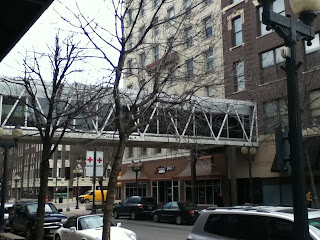(Skywalk System enters the Higley Building)
I've been reading a lot lately about the New Urbanism, which has been very interesting and provocative, and which I expect to address in a post soon. One of the best books in the area is Suburban Nation: The Rise of Sprawl and the Decline of the American Dream by a trio of planners: Andres Duany, Elizabeth Plater-Zyberk and Jeff Speck (North Point Press, 2000). (Ms. Plater-Zyberk is also the Dean of the School of Architecture at the University of Miami.) Amidst an impressive array of pertinent observations and recommendations, the trio takes part of chapter 9 to inveigh against "pedestrian bridges." This struck me forcefully, because as I've already told you, I love love love Cedar Rapids's Downtown Skywalk System.
Duany et al. argue that skywalks work against urban vitality. Cities, to succeed, must be designed to do what cities do best: provide "a public realm, with the vibrant street life that phrase implies" (p. 156). That means city neighborhoods, particularly downtowns, must offer a mix of eating, shopping, working and socializing, so that there is activity at any hour of the day and night. And in the center of this is, not streets full of cars, but sidewalks full of pedestrians. Skywalks, they say, are designed to achieve two goals, both of which work against urban vitality: (1) get pedestrians out of the way of cars so they can move more freely and quickly through downtown streets; and (2) get professional people up and away from icky poor people on the street. They discount factors related to adverse weather that might make walking unpleasant during long hot summers in Dallas or long cold winters in Minneapolis (or Cedar Rapids): "Only in the most extreme conditions has bad weather proved capable of eliminating pedestrian traffic along a properly designed street. There is more sidewalk-fronting retails space in Toronto than in all the cities of the Sun Belt combined" (p. 159n).
In that same footnote, they quote a 1992 article by Trevor Boddy: "Precisely because downtown streets are the last preserve of something approaching a mixing of all sectors of society, their replacement by the sealed realm overhead and underground has enormous implications for all aspects of political life. Constitutional guarantees of free speech and of freedom of association and assembly mean much less if there is literally no peopled public space to serve as forum in which to act out these rights."
Before I respond, I'll pile on with more consideration: In a stretched city budget, would I rather see Cedar Rapids (a) expand the Skywalk System; (b) extend our rudimentary trails system; (c) build sidewalks on Prairie Drive NE and Memorial Drive SE; (d) reclaim some of our endless acres of surface parking for some more useful purpose? Well, I'd like to do all of those things, but I must admit "(a)" is at the bottom of the priority list.
So why do I love the Skywalk System so much. (Gee, after writing the above paragraphs, maybe I don't!) Part of it has to do with the frequently hostile weather in our town, and yes, the fact that drivers are not conditioned to look for pedestrians. Just yesterday, a woman turning right onto 4th Av, eyeing a parking space on the far side of the street and enjoying a vigorous conversation with her passenger, got uncomfortably close to your author. But I can do better than that.
One thing I love about the Skywalk System, and which somewhat redeems it from the criticisms made by Duany, Boddy and others, is its utter impracticality. Walking the skywalks is an adventure. Far from paralleling the sidewalks, the skywalks twist and turn all over the place. Last week I overheard one of the public library staff telling her colleague, "On the skywalks it takes you four blocks to go two." They're better signposted than they used to be, but back in the '90s it was a well-known challenge to get from one end to the other without getting lost. It's not quite an autonomous ramble through uncharted territory, but it can feel pretty close.
Secondly, the Skywalks put me in buildings I'd never be in otherwise, at least not up to the second or third floors. Some of the most venerable architecture remaining in Cedar Rapids, a city that has long loved to tear itself down, is in the downtown commercial district. The skywalks run you through the American Building (1913, pictured below), the Higley Building (1918), the Dows Building (1930), and other places that exude history and where I'd have no other business being. I'm not sure the staff of Scherup Blades or United Fire and Casualty need me to walk down their hallways, but I'm grateful for the chances to do so.
The skywalks were already here when we moved to Cedar Rapids in 1989, so I wasn't around for the discussions around building them. But I'm glad they're there, and now I've got my sons into them, too!
(Below: the American Building, completed in 1913, is one terminus of the twisted and confusing and totally lovable Skywalk System)
A couple programming notes:
1. I'm doing a talk at church this weekend on "third (in-between) places." I'll summarize the discussion next week.
2. "World Cafe," a public radio program out of Philadelphia has an occasional series called "A Sense of Place." Next week they're featuring Nashville.






No comments:
Post a Comment